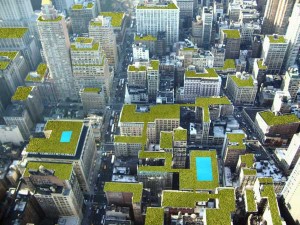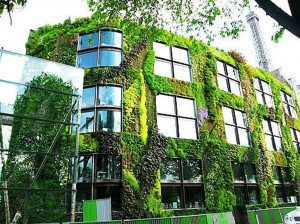As a former conservation student, I have always enjoyed exploring ideas about improved sustainable options. At the beginning of the year, while I was in search of a thesis topic, I was very much interested in rooftop gardens and the possibility of contributing to sustainable living, specifically focussing Cape Town. This idea included combining modern sustainable methods with the use of available natural resources.
The challenge would be to explore these possibilities and find a way to combine them with the subject of climate change and CO2 mitigation. Hence, some further exploration into the effects of rooftop gardens on CO2 levels.
The first green roofs initiated in Germany (1960) and since then have spread across the world whilst increasing the technology and opportunities. Rooftop gardens have said to reconnect city-dwellers with nature. Wildlife may also find shelter in these areas while urban agriculture can lead to higher food supply. Our surrounding environment (eg. Fynbos) can to a certain extent be replicated on rooftops and in some cases even help protect vulnerable plant species.
There are many benefits to rooftop landscaping, from basics of aesthetics to more important global impacts of CO2 exchange and albedo effects. As we all know, surface vegetation is an extremely important factor in the earth’s climate since evapotranspiration impacts rainfall and temperature. It has been proven that vegetation cover can significantly influence climate and albedo, if they are of large magnitude. This is done by exchanging CO2 and greenhouse gasses such as N2O and CH4 between the biosphere and the atmosphere. This biogeochemical feedback between vegetation and climate through CO2 concentrations can be facilitated by increased rooftop gardens. Like household gardens, they can be manipulated to our needs by implementing a different design depending on the maintenance efforts. So why not shift to an environment where biodiversity is increased, vulnerable species maintained and CO2 increases alleviated?
Biodiversity can be increased, to such an extent that moss and lichens will grow on slates or tiles on the roofs of buildings. Although biodiversity can be managed, I believe we should plant C3 photosynthetic plants that would thrive in a CO2 increasing world. This should then enable pollutants, airborne particles and CO2 to be filtered from the atmosphere by the rooftop vegetation. In effect, we would be breathing oxygen into the air while companies reduce their carbon footprint. However, it should not be seen as a trade-off for exploiting other CO2 increasing methods.
The need to decrease greenhouse gasses that play a major role in global warming has amplified after recent measurements at Mauna Loa observatory in Hawaii indicated atmospheric CO2 levels of 400 ppm. This global benchmark is 100% due to human activity – therefore we should take responsibility for our actions and alleviate such predestined changes. We should consider small changes with big impacts and possibilities.
Every time I see the pollution hanging over Cape Town like rolling mist, I wish the wind would blow it away, but now we have a chance to speed up the process and improve air quality with increased land cover or rather roof cover. We may even reduce the heavy heat from summer months but only in our immediate microclimate.
Vegetated areas in relation to bare ground have strong effects on albedo and evapotranspiration. These vegetated rooftops will slowly absorb heat from the sun and increase shade that will decrease the use of air-conditioning which saves even more energy (electricity). Rooftop gardens and garden walls will also reduce glare and reflected sunlight (albedo) making the city cooler and more liveable. Wouldn’t it be cool to live in a city similar to the hanging gardens of Babylon?
Regarding previous water restrictions and overall freshwater decrease, a shift towards increased vegetated buildings would assist the city to store more water and increase greywater recycling. Scientists has also mentioned that plants help to slow climate change by emitting gases as temperatures rise that lead to the formation of a sunshade of clouds over the planet.
As this initiative expands across the city we would be able to facilitate slower climate change by absorbing greenhouse gases. Even if plants only increased the amount of water vapour in the air, forming clouds would still assist the albedo. Furthermore land cover impacts the amount of CO2 stored underground – this does raise the question of where does CO2 go on rooftop gardens, with a limited soil cover and low saturation levels.
Since we are unsure of the specific CO2 level that would stop the effects of global warming, shouldn’t we at least attempt to mitigate the rise in CO2? Within the scope of the most recent 400ppm crossing this initiative towards a literally greener city should be encouraged.
References:
Brovkin, V., Boysen, L., Raddatz, T., Gayler, V., Loew, A., Claussen, M. 2012. Evaluation of vegetation cover and land-surface albedo in MPI-ESM CMIP5 simulations. Max Planck Institute for Meteorology, Bundesstr. 53, 20146,
Shukla, J., Mintz, Y. 1982. Influence of Land-Surface Evapotranspiration on the Earth’s Climate. Science, New Series, Vol. 215, No. 4539. pp. 1498-1501.
Witten, J., Sam, J., 2011. Rooftop Landscapes Make Gardening on Roofs a Possibility. SA Roofing. Green Roofing. Or http://www.rooftoplandscapes.co.za/admin/ckeditor/litsoft-fm_v1.00/userfiles/files/SA_Roofing_March_2011_Green_Roofing.pdf
http://www.news24.com/Green/News/Rise-of-CO2-levels-now-urgent-20130429
http://www.news24.com/Green/News/Plants-slow-climate-change-with-sunshade-20130428
http://www.news24.com/Green/News/Forests-more-resilient-to-climate-change-20130310


Greg Dor
Adding to Deans comment don’t plants also respire at night? I guess the net result may be an uptake of CO2 but if you add this to the other emissions required to implement this project, the net result may be an increase of CO2. It would be an interesting study to see what the results would be. I do however like the idea from an aesthetic point of view as I think it would contribute to the happiness and well being of the inhabitants of the city and also promote a sense of pride and awareness of nature and its benefits
Dean Harrison
Going back to the rooftop gardens. I think it is a great idea but I don’t think think it will contribute much to a reduction in greenhouse gas emissions. I see the value in veggie gardens (food supply), possible employment opportunities and even the mental health gardening provides. However, what is done with the natural waste (garden cuttings)? The soil is too thin and space is limited to recycle the waste as compost on site. Therefore the waste would need to be transported off-site. If this is a highly urbanised area (let’s use the example of the New York skyline shown in your second image), then this waste would need to be transported long distances in heavy traffic.
Would the added CO2 emissions of garden waste removal not offset any benefit obtainable from carbon sequestration of rooftop gardens????
Secondly, wouldn’t rooftop gardens lead to a reduced albedo and therefore HIGHER temperatures?
Thank you for the post. It was a very interesting read
Laetitia
Unfortunately, that’s not a feasible soutoiln. First, the amount of roof-top area in the world is relatively small compared to the planets surface. Second, a lot of energy (thus CO2 emissions) would need to go into manufacturing whatever white rooftop covering were used.If you live in a hot area, it’s a good idea for new construction, as it will save your cooling energy requirements. But if you live in a cold area, it may actually increase your heating energy requirements.
Archie
Actually what would really help is to have a brhigt white and black tile into one that could be switched according to the seasons. Yes, some light would be reflected back into space with the white roof tile in the summer and in the winter less energy would be consumed heating the house saving on green house gas emission. I’ve thought about inventing this baby but I’m not greedy whoever wants a go at it be my guest. It would only serve the world for the better. I just hope whomever profits from it would commit a large portions of the profits to helping save the environment from utter collapse due to anthropogenic forces.
Shakirudeen
This is a GREAT piece and i really love it. I completely agree with you that even if this is a baby step towards reducing anthropogenic greenhouse gases emissions, it is a good step in the right direction. It is true that in addition to rooftop garden replenishing the atmospheric oxygen, it also increases biodiversity. One question however, is how do we reduce the cost of this green initiative so that it is affordable to all? This is important because the availability of this technology will have a huge impact in the reduction of atmospheric CO2.
I agree with Gemma that a demonstration is needed for the general acceptance of this idea. I therefore, suggest that this should be a national project with focus on reducing carbon footprint (in line with Gemma’s thought).
Gemma Bluff
I really LOVE this concept of green buildings and roofs. I think it’s the way forward for modern architecture, and can do a lot of good in replenishing the oxygen levels (as deforestation and land-use change continues), amongst other purposes. Your comment “Rooftop gardens and garden walls will also reduce glare and reflected sunlight (albedo) making the city cooler and more liveable” is a vital one, that many cities could use – especially as urban heat islands grow and intensify. It looks great, and it does a job, so why not implement it immediately? Granted it costs money, but if rooftops were set up with a visible functionality, such as veggie gardens, it would serve 4 purposes: feeding a community (well at least helping), decreasing urban islands, changing the albedo of cities, and increasing oxygen levels in and around the city centre. I think that communities in and around cities (and in the suburbs) would be more open to the idea if they could see and feel the differences for themselves. Just telling people about scientific positive outcomes isn’t enough to spark acceptance and implementation, but seeing is believing. If this mitigation method were implemented in conjunction with carbon footprint reduction, I do believe we’ll be heading in the right direction. Sure it may not be enough to make a significant difference to the damage that has already been done by anthropogenic activities, but I truly believe that some action is always better than inaction.
Great topic Kobus!